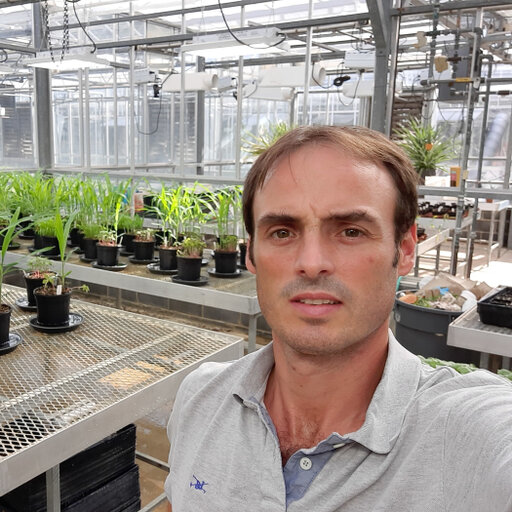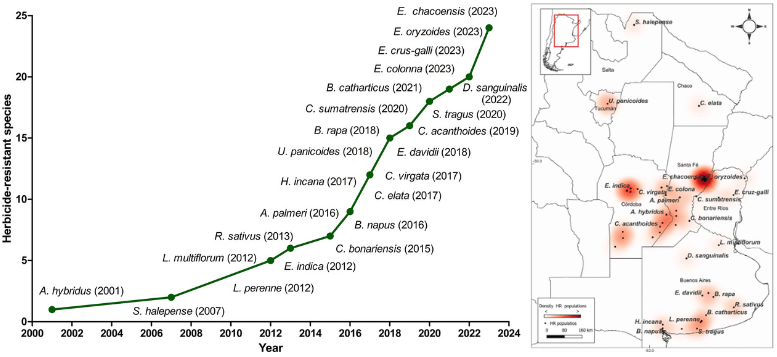“…there are 43 populations of herbicide-resistant weeds, belonging to 24 different species. Of these 43 populations, there are 9 populations with multiple resistance…”
Fernando Oreja is a researcher at Oregon State University and an expert on weeds in Argentina. Oreja is an agricultural engineer, with a Ph.D. in agricultural sciences from the Faculty of Agronomy of the University of Buenos Aires, with a postdoctoral degree from North Carolina State University.

Fernando Oreja, expert on weeds
AgriBrasilis – Why is the population of resistant weeds in Argentina increasing?
Fernando Oreja – The country’s weed population is increasing due to the repeated use of the same herbicides. The change in the sowing system, from conventional tillage to no-till, has eliminated the mechanical control of weeds and their control began to depend exclusively on herbicides. Furthermore, no-till was possible thanks to the adoption of herbicide-tolerant crops, which allowed the products to be applied as many times as necessary, even after the commercial crop had grown. All of this increased selection pressure for herbicides, especially in the case of glyphosate.
AgriBrasilis – What is the panorama for weed resistance in the country? How many cases of multiple resistance are there?
Fernando Oreja – In Argentina, at the time we published our latest research, there were 43 populations of herbicide-resistant weeds, belonging to 24 different species. Of these 43 populations, there are 9 populations with multiple resistance, the vast majority of which are resistant to glyphosate.
The herbicide with the most cases of resistance is by far glyphosate, with 92% of resistant populations, followed by ALS inhibitors, with 29%, and auxin inhibitors, with 17%. Only 8% of populations are resistant to ACCase inhibitors, and 4% to PPOs.
AgriBrasilis – Glyphosate is the herbicide with the most cases of resistance. Did agrochemical companies provide any guidance on the proper application of this product?
Fernando Oreja – Yes. In the beginning, it was considered that this herbicide had a low probability of emergence of resistant populations compared to other herbicides, but once cases of resistance began to appear, pesticide companies began to make recommendations to reduce the emergence of new resistant populations. For example, some of these recommendations are: to apply only the commercial dose of the herbicide, with the plant size suggested on the product labels, to use water of adequate quality, and avoid mixtures of herbicides with antagonism, etc.
AgriBrasilis – Which weeds are most worrying and in which crops? Which regions of Argentina are the most affected?
Fernando Oreja – The most worrying weeds are pigweed, or Amaranthus hybridus and Amaranthus palmeri, followed by perennial and annual ryegrass (Lolium perene and Lolium multiflorum) and species belonging to the Brassicaceae family, such as Raphanus sativus, Brassica rapa, Brassica napus and Hirschfeldia incana. Horseweed (Conyza sumatrensis and Conyza bonariensis) is also important.
The crop with the highest number of resistant populations is soybean, with 74% of the species showing high resistance to glyphosate and ALS inhibitors, followed by corn, with 40% resistance to glyphosate and ALS inhibitors. Wheat is the third crop with the highest number of populations, with 30% (highest incidence of resistance to ACCase inhibitors).
The most affected regions of the country are the Central Zone and South Zone of the provinces of Santa Fe and Córdoba, where summer weed species predominate, and the southern zone of the province of Buenos Aires, a typical wheat area, where species of winter weeds predominate.
AgriBrasilis – What measures can mitigate the problem of resistant weeds? Is “Integrated Management” the only answer?
Fernando Oreja – Yes. As the emergence of resistant weeds is an evolutionary phenomenon, removing the factor that is selecting the plants (in this case, the herbicide) is the best way to reduce the growth of these populations.
Removing herbicides from the agricultural system may not be a simple task, and for this we consider that integrated management measures must be adopted, which consider all control options: distance between rows, planting density, planting of more competitive genotypes, modification of sowing dates, crop rotation, adoption of cover crops, rotation of herbicides with different modes of action, combination of residual and contact herbicides, use of commercial doses of herbicides and with plants of adequate size, use of mechanical control when possible, etc.
READ MORE:

